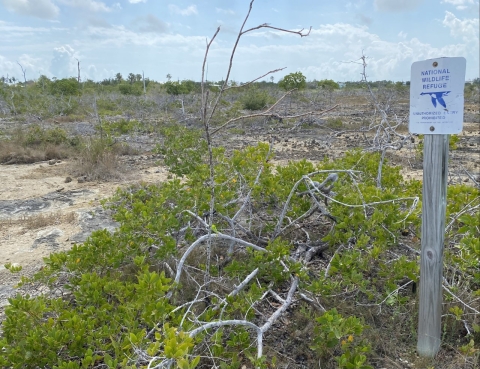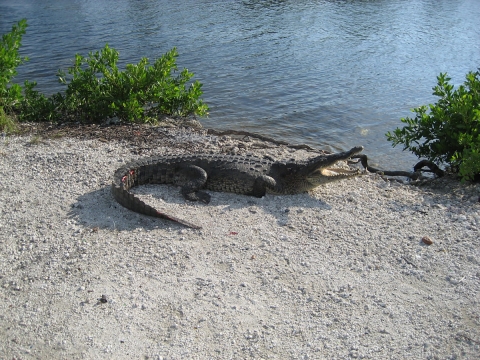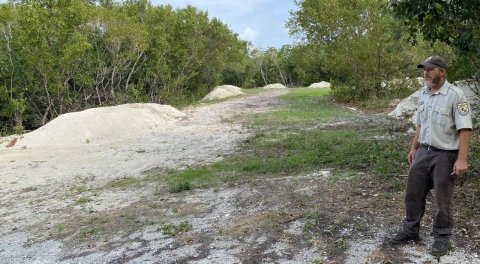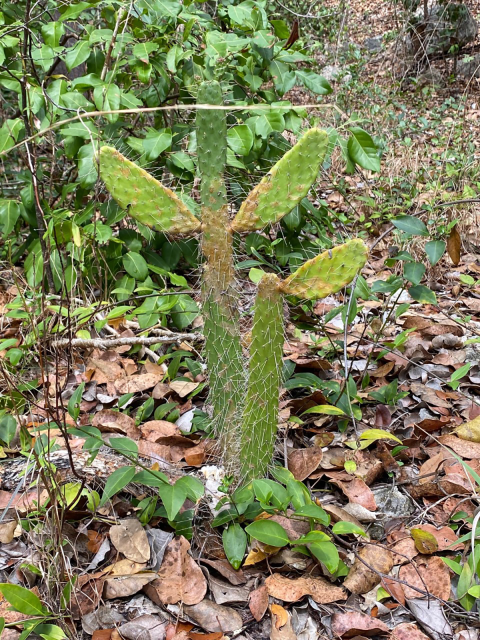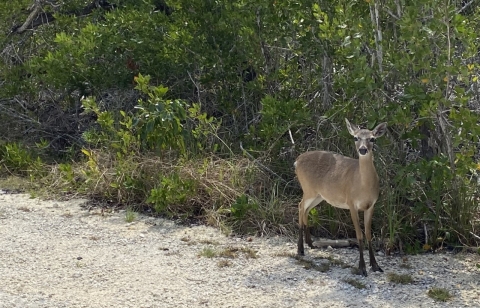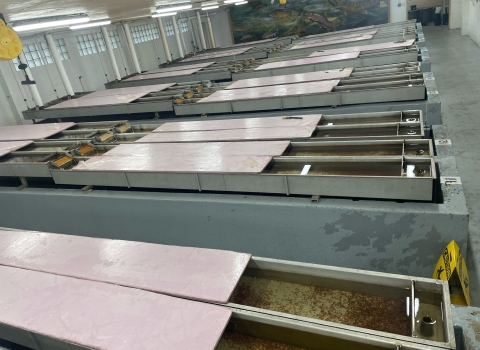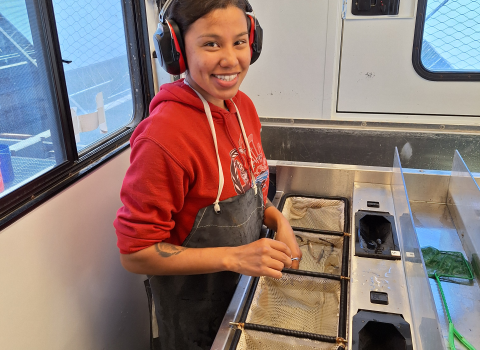Big Pine Key, Florida – The half-mile swath of piney rocklands, where Palm Avenue ends and a lunar-like landscape begins, shows in stark detail the relentless changes wrought by an ever-warming world.
At one end of the limestone-pocked flat stand the slash pines with a healthy understory of grasses, herbs, and thatch palms. At other end, near a saltwater pond and a mosquito-control ditch, sit the low-lying black mangroves and the desiccated stumps of pines, buttonwoods and poisonwoods.
“And this is the transition zone,” says Kevin Kalasz, a Coastal Program Coordinator with the U.S. Fish and Wildlife Service, while standing midway between the two very different ecosystems. “It’s been converted from a pine rockland to a salt barren. And, eventually, those robust pine trees 200 meters up there will also begin to look like this.”
If low-lying Florida is the poster child for climate change climate change
Climate change includes both global warming driven by human-induced emissions of greenhouse gases and the resulting large-scale shifts in weather patterns. Though there have been previous periods of climatic change, since the mid-20th century humans have had an unprecedented impact on Earth's climate system and caused change on a global scale.
Learn more about climate change run amok then the Keys are the troubled siblings struggling against rising seas and saltwater intrusion. Nowhere in the hundred–and-fifty-mile-long archipelago does the elevation rise above 18 feet. Average height of the tropical string of islands: 3.2 feet above sea level. It doesn’t take a rocket scientist to discern what harm a projected three-to-eight-foot rise in the Atlantic Ocean by 2100 will do to the Keys.
“The sea is rising much faster than it rose over the last three millennia, and it’s already having profound impacts on natural communities, vegetation and wildlife,” says Chris Bergh, who grew up in the Keys and works for The Nature Conservancy (TNC). “Under the best-case scenario, sea level rise will have a big impact. Under the worst-case scenario, Big Pine and the lower Keys will be nearly completely inundated with sea water.”
But nobody’s waving the white flag just yet, especially when it comes to protecting the threatened and endangered animals and plants that help make the Keys so unique. Atop just about everybody’s list of charismatic critters is the Key deer, the cute-as-a-button federally endangered ungulate that sits in the crosshairs of a rampaging Mother Nature. Fish and Wildlife, which administers the Endangered Species Act, is updating its recovery plan for the Key deer, explicitly to take into account climate change. There are no recommendations to change its endangered status.
The Service is also boosting recovery efforts for American crocodiles, Key Largo woodrats, Miami blue butterflies, Florida semaphore cactuses, and other Keys species under the climate gun. A slew of climate mitigation efforts, including moving species to higher grounds, is also underway across the Keys.
“The ESA doesn’t give us an off-ramp to deal with climate change,” Kalasz says. “It says we cannot allow for extinction, or we have to minimize the risk of extinction, and that is it. We can’t just say this problem -- climate change -- is too big.”
“Coming up quick”
In Key Largo, the northernmost inhabited Key, Jeremy Dixon helps endangered American crocodiles outsmart climate change. Dixon manages the aptly named Crocodile Lake National Wildlife Refuge, a series of upland hardwood forests and saltwater mangrove thickets. The mangroves, increasingly, overtake the hardwoods.
The crocodiles, kin to the more numerous, darker-skinned American alligators, are federally listed as threatened in Florida. Rampant development and skin-seeking hunters decimated crocodile numbers. At one time, only 70 remained in south Florida. Steadily rising brackish water inundates their breeding grounds.
“I’ve been here nine years and I can definitely tell you that the water’s coming up quick,” Dixon says en route to an off-limits tract of land on the Atlantic Ocean side of the island. “On the water’s edge, where the saltwater is moving in, we’re transitioning from upland species to wetland species. At some point buttonwoods can’t withstand saltwater inundation so it’s transformed into mangroves. Change is happening so fast. We’re seeing huge impacts.”
Crocodiles either dig holes in the sand or build mounds out of sand, pebbles and shrubs, before laying their eggs. In the climate-troubled, mangrove-rich Keys, sandy beaches are increasingly hard to find. Old crocodile breeding grounds succumb, increasingly, to the rising sea.
Over the last 15 years, the Service, along with state, federal and nonprofit partners, built 40 maternity wards for expectant croc moms on the refuge. Placement of the five-foot-long, two-foot-tall sand mounds is critical: they must be far enough from the marauding salt water, yet close enough to the nutrient-rich mangrove swamps for hatchlings. Once an egg hatches, the mama croc will carry her baby to the nearby pond, cove, or creek.
At a crescent-shaped tract of land on the refuge, Dixon and others constructed 20 berms from construction-grade sand. During last year’s nesting season, between March and May, crocodiles occupied three of the berms. Dixon’s crew tagged more than 40 hatchlings – a testament to pro-active, climate-fighting, wildlife-management tactics.
Today, an estimated 2,700 crocodiles live mostly in the Keys and the Everglades.
“What we’re doing is working,” Dixon says. “The cool thing is you can manipulate a crocodile’s habitat so they will use a spot they normally wouldn’t. Crocodiles can adapt to their environment. They'll use what’s available. You put sand out here and they’ll be happy.”
Outrun climate change
But for how long? The Atlantic Ocean off Florida has risen almost a foot the last century and will likely rise at least another foot by 2050. Key Largo sits, on average, seven feet above sea level and will likely lose hundreds, if not thousands of acres of coastal habitats.
“Florida is among the most vulnerable states to climate change impacts, primarily due to a combination of increasing ocean temperatures, sea level rise, extreme weather events, low elevation, and heavy coastal human development,” reads the National Fish, Wildlife, and Plants Climate Adaptation Strategy published last year by the National Oceanic and Atmospheric Administration and other federal agencies. “As wildlife begins to move, tracking to more suitable habitats and following shifting vegetative communities, species will likely encounter existing ecological threats, such as extensive human development, which will exacerbate strain on species of greatest conservation need.”
Like saltwater-slammed cactuses. In the Keys, the endangered Florida semaphore and key tree cactuses struggle to escape the onslaught of the Atlantic Ocean. The Service is helping them flee to higher ground.
Like the crocodiles, semaphores were about poached out of existence by the 1970s, prized by cactus enthusiasts as adornments to gardens and greenhouses. Two wild cactus sites remained, one in the upper Keys and another in the lower Keys, by the time the semaphore was listed as endangered in 2013. And rising, salty seas posed an even greater threat. That year, the Service planted 300 cacti on Crocodile Lake and Key Deer refuges. They were placed on (relatively) high ground between the rocklands and coastal swamps.
The semaphores flourish at the old Port Bougainville condo and marina mega-development that went belly up in 1984. The 406-acre property was then turned into the Crocodile Lake refuge and a state park. Semaphore pads were scooped up from other sites and transplanted onto a limestone ridge 12 feet above the lagoon – whose decrepit wooden docks are favored by sunning crocodiles – surrounded by poisonwood, wild tamarind, and wild coffee trees. Several dozen cactuses dot the landscape, some rising four feet with spiny pads that drop off and naturally take root. In all, hundreds of semaphore cactuses have outrun climate change on conservation lands across the Keys.
Transplanting plants or animals remains controversial, though. Biologists worry that helping species migrate to more hospitable locations may spread diseases and otherwise negatively impact a new location. They also wonder whether a unique and endangered plant or animal maintains its biological distinctiveness if it’s plunked down in an alien environment. A Key deer, for example, may no longer be a Key deer if its gene pool is diluted by mating with a white tail deer. The semaphores, though, were once abundant on Key Largo and other Keys, so restoring them to their natural habitats isn’t really controversial unlike, say, capturing Key deer and moving them to the Everglades.
Buying time
In the early 2000s, Fish and Wildlife translocated 39 Key deer from Big Pine and No Name keys, where most of the elfin deer live, to Sugarloaf and Cudjoe keys. The deer once roamed the entire Lower Keys, so moving a small number to Sugarloaf and Cudjoe for health and safety reasons raised few concerns.
Climate change, though, poses different, existential challenges to their survival. While the Service isn’t proposing to translocate any deer off the keys, the Service’s biologists are feverishly working to improve existing deer habitat, all the while watching as the seas rise.
Key deer were listed as endangered in 1967 after hunters, and, later, developers, parasites, and motorists, reduced their numbers to the dozens. Robust protections, habitat improvements, and room to grow with the establishment of the National Key Deer Refuge on Big Pine and No Name keys boosted their numbers to 1,000. A parasitic disease in 2016, though, and a major hurricane the following year, cut the population in half. Today, an estimated 725 deer roam the Lower Keys.
Fish and Wildlife just released an amended recovery plan which spells out the “objective, measurable criteria” necessary to determine if the deer will ever be de-listed and lose the protections of the Endangered Species Act. The answer, in short, is not any time soon. The reason? A greater appreciation for the impact a steadily warming world will have on Key deer habitat. To consider delisting the species, it must “be demonstrated that habitat loss associated with sea level rise is diminished such that enough suitable habitat remains in the foreseeable future.”
And that, according to scientists at NOAA, isn’t likely to happen.
“The conservation measures for Key deer have been extremely successful and, if it wasn’t for sea level rise, I wouldn’t be too worried about them,” says Bergh, the south Florida program manager for TNC. “But is it an animal in danger of extinction in the relatively near future? I say, absolutely, yes. If we’re not planning on 15 inches of sea level rise by 2050 then we are not going to be doing right by these animals.”
Kristie Killam, a park ranger at Key Deer refuge, dips a plastic cup attached to a long tube into Central Slough. She retrieves the cup and tests the water’s saltiness with a refractometer. The average salinity of ocean water is 35 parts-per-thousand. For freshwater, it’s zero parts. Deer, Killam says, won’t drink anything over 10 PPT.
“It’s 11,” she says, adding, “I rarely see a deer in here.”
The slough is clearly brackish with dead trees and shrubs and stagnant water. Old roads, laid for a never-built development, run perpendicular to Key Deer Boulevard. Sea water burbles up through the limestone during high tides. Storms scoop up ocean water and deposit it in three-acre pond. Upon evaporation, the salt seeps down into the muck ensuring that deer will rarely get a fresh drink of water.
Fish and Wildlife, TNC, and the state of Florida are spending $1 million to rejuvenate the one-time freshwater marsh. They’ll reconnect the slough to other water bodies via a series of pipes, dams, and risers. They’ll rip up the roads. They’ll lay fire on the land to clear out the underbrush. And they’ll let native plants grow to, once again, attract Key deer, marsh rabbits, mud turtles, and migratory birds.
But why spend so much money if Big Pine Key and its Key deer could be under water in fifty years?
“A project like this buys us some time,” Kalasz says. “Let’s improve the habitat’s conditions as best we can for the animals until we can, hopefully, do what we need to do to slow climate change and sea level rise. I’d rather my legacy be that we tried rather than we did nothing.”

